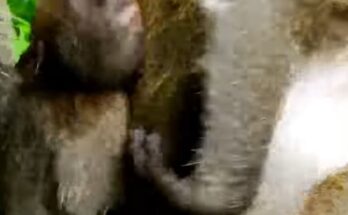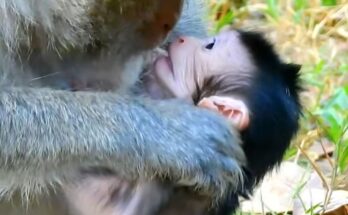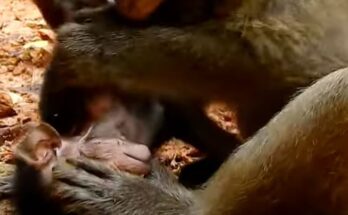Baby monkeys are often seen as adorable creatures, their playful antics and curious eyes evoking feelings of warmth and joy. However, recent reports and images of baby monkeys with injured faces have sparked widespread concern and a flood of questions. What could cause such harm to these vulnerable animals, and what does it tell us about their lives and the environments they inhabit?
The Possible Causes
There are several reasons why baby monkeys might suffer from facial injuries, ranging from natural occurrences to human interference.
1. Aggression Within Troops
Monkeys, like many social animals, live in hierarchies where dominance plays a significant role. In some cases, adult monkeys or even other juveniles may exhibit aggressive behavior toward younger or weaker members. This aggression can stem from competition for food, disputes over social ranking, or even stress within the group. Baby monkeys, being smaller and less experienced, are particularly vulnerable to such attacks. Facial injuries could result from bites, scratches, or other physical confrontations.
2. Predator Attacks
In the wild, monkeys face threats from a variety of predators, including large birds, snakes, and carnivorous mammals. A baby monkey’s face, being one of its most exposed areas, can easily sustain injuries during an attempted predation event. While a mother monkey often does her best to protect her young, successful attacks can leave the babies with lasting scars.
3. Human Interference
Unfortunately, human activities often contribute to the suffering of wildlife. In some areas, monkeys are captured for the illegal pet trade, research, or entertainment purposes. In captivity, they may be subjected to abuse or neglect, leading to physical injuries. Additionally, in urban areas where monkeys and humans frequently interact, incidents of violence—whether intentional or accidental—can cause harm to these animals. For instance, monkeys scavenging in urban spaces may be struck by vehicles or attacked by frightened humans.
4. Environmental Hazards
Monkeys living in degraded or urbanized environments often encounter dangers that their natural habitats would not pose. For example, injuries could result from entanglement in discarded wires, cuts from broken glass, or burns from chemical spills. These hazards are particularly concerning as they are entirely preventable with better waste management and environmental practices.
5. Medical Conditions and Infections
In some cases, what appears to be an injury may actually be a medical condition. Infections, skin diseases, or congenital issues can cause severe facial deformities or wounds. Parasitic infestations, for instance, can lead to open sores, while viral or bacterial infections might cause swelling and lesions.
The Role of Observation and Research
Understanding the exact causes of such injuries requires observation and research. Wildlife biologists and veterinarians often study monkey populations to monitor their health and behavior. By identifying the patterns and circumstances surrounding these injuries, experts can propose solutions to mitigate the risks.
For example, if injuries are predominantly caused by human activities, stricter regulations and better coexistence strategies can be implemented. Similarly, if environmental hazards are the primary culprit, local authorities can take steps to clean up and secure habitats.
The Ethical Concerns of Viral Content
Images and videos of injured baby monkeys often go viral on social media, drawing both sympathy and outrage. While raising awareness is important, it’s equally critical to question the ethics of sharing such content. In some cases, these images are exploited for views and engagement, with little regard for the animals’ welfare.
It’s also worth noting that some viral content may be staged. Unscrupulous individuals have been known to harm animals intentionally to evoke emotional reactions from viewers. This dark side of content creation underscores the need for vigilance and responsible sharing.
What Can Be Done?
Addressing this issue requires a multi-faceted approach:
- Education and Awareness: Educating communities about the importance of coexisting with wildlife can reduce human-animal conflicts. Teaching children and adults alike to respect animals and their habitats can foster more harmonious relationships.
- Stricter Regulations: Governments and organizations must enforce laws against illegal wildlife trade and animal cruelty. Punitive measures can deter harmful behaviors, while rehabilitation efforts can help injured animals recover.
- Habitat Preservation: Protecting and restoring natural habitats is crucial for the survival and well-being of monkey populations. Cleaner environments mean fewer injuries from human-made hazards.
- Support for Conservation Efforts: Donating to or volunteering with conservation groups can make a tangible difference. These organizations often work to rescue injured animals, provide medical care, and release them back into the wild.
- Responsible Media Consumption: As viewers, we have a responsibility to question the sources and motives behind viral content. Supporting ethical creators and avoiding exploitative material can help shift the narrative toward positive change.
Conclusion
The sight of baby monkeys with injured faces is heartbreaking, but it serves as a powerful reminder of the challenges these animals face. Whether the result of natural causes or human interference, each injury tells a story of survival and resilience. By understanding the causes and taking proactive steps, we can work toward a world where these vulnerable creatures are protected and cherished, ensuring they thrive in their natural habitats.


